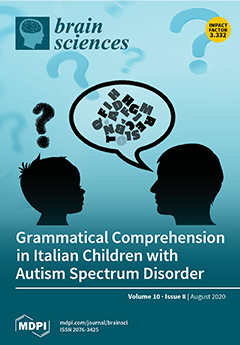(1) Objective: The objective was two-fold: (a) test a protocol of combined interventions; (b) administer this combined protocol within the framework of a six-month, intensive, long-duration program. The array of interventions was designed to target the treatment-resistant impairments underlying persistent mobility dysfunction: weakness,
[...] Read more.
(1) Objective: The objective was two-fold: (a) test a protocol of combined interventions; (b) administer this combined protocol within the framework of a six-month, intensive, long-duration program. The array of interventions was designed to target the treatment-resistant impairments underlying persistent mobility dysfunction: weakness, balance deficit, limb movement dyscoordination, and gait dyscoordination. (2) Methods: A convenience sample of eight chronic stroke survivors (>4 months post stroke) was enrolled. Treatment was 5 days/week, 1–2.5 h/day for 6 months, as follows: strengthening exercise, balance training, limb/gait coordination training, and aerobic exercise. Outcome measures: Berg Balance Scale (BBS), Fugl-Meyer Lower Limb Coordination (FM), gait speed, 6 Minute Walk Test (6MWT), Timed up and Go (TUG), Functional Independence Measure (FIM), Craig Handicap Assessment Rating Tool (CHART), and personal milestones. Pre-/post-treatment comparisons were conducted using the Permutation Test, suitable for ordinal measures and small sample size. (3) Results: For the group, there was a statistically (
p ≤
0.04) significant improvement in balance, limb movement coordination (FM), gait speed, functional mobility (TUG), and functional activities (FIM). There were measurable differences (minimum detectible change: MDC) in BBS, FM, gait speed, 6MWT, and TUG. There were clinically significant milestones achieved for selected subjects according to clinical benchmarks for the BBS, 6MWT, gait speed, and TUG, as well as achievement of personal milestones of life role participation. Effect sizes (Cohen’s D) ranged from 0.5 to 1.0 (with the exception of the (6MWT)). After six months of treatment, the above array of gains were beyond that reported by other published studies of chronic stroke survivor interventions. Personal milestones included: walking to mailbox, gardening/yardwork, walking a distance to neighbors, return to driving, membership at a fitness center, vacation trip to the beach, swimming at local pool, returning to work, housework, cooking meals. (4) Conclusions: Stroke survivors with mobility dysfunction were able to participate in the long-duration, intensive program, with the intervention array targeted to address impairments underlying mobility dysfunction. There were either clinically or statistically significant improvements in an array of measures of impairment, functional mobility, and personal milestone achievements.
Full article






